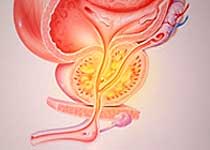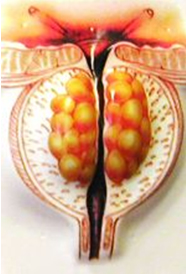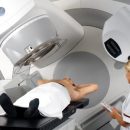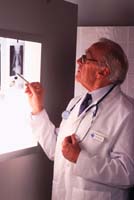You avoid visiting public places and take long journeys because you are afraid of waiting in line in the toilet. You no longer wear light pants, because you are afraid to wet them and it can notice. Read what happens to the body.
Content
What is prostate adenoma?
 Prostate adenoma (benign prostatic hyperplasia, DGPH) is one of the most common urological diseases of men of mature age.
Prostate adenoma (benign prostatic hyperplasia, DGPH) is one of the most common urological diseases of men of mature age.
According to the latest statistical data, at the age of 40 years, 50% of men have changes in the prostate gland associated with its increase (hyperplasia), and after 80 years, each man has prostate adenoma.
The development of the disease is associated with the violations of the hormonal background of the body, which are observed with almost all men after 40-45 years (the so-called male climax or andropause). However, at present, many key mechanisms for the occurrence of prostate adenoma remain not clear, which does not allow to develop enough effective measures to prevent this disease.
The gradual increase in the prostate gland leads to the compression of the urethra passing through it, and the violation of the normal urine outflow from the bladder. Depending on the stage of the disease and size of prostate gland prostate, prostate adenoma can cause a minor reduction in the flow rate of urine to the development of a complete urethral block and the impossibility of emptying the bladder, which is an emergency state requiring emergency medical care.
Unfortunately, in our time, despite the emergence of new diagnostics and treatment and treatment of DGPH, the late stages of the prostate gland adenoma, leading to the development of typical complications of this disease, are not rare. This is mainly due to the fact that most men do not give the proper value of this pathology and regard the emerging symptoms of increasing the prostate gland as a normal condition due to age and not requiring any treatment.
At the same time, the timely identification and treatment of prostate adenoma avoids serious complications of this disease and significantly improve the quality of life.
How to suspect prostate aden?
The first manifestation of prostate adenoma associated with an increase in prostate gland and urinary outflow is the following:
- Veliast jet of urine
- Intermittent urine release at the end of urination
- Increase the time of urination
- Need to strain the muscles of the abdominal press for complete emptying of the bladder
 Such symptoms increase slowly and often remains unnoticed. However, as the prostate of the muscle tension of the bladder and the abdominal press is not enough to overcome the block caused by adenoma, – In the bladder begins to accumulate residual urine. If the residual urine is much, there is a sense of incomplete emptying of the bladder, and other symptoms of prostate adenoma appear caused by functional disorders and a decrease in free volume in the bladder:
Such symptoms increase slowly and often remains unnoticed. However, as the prostate of the muscle tension of the bladder and the abdominal press is not enough to overcome the block caused by adenoma, – In the bladder begins to accumulate residual urine. If the residual urine is much, there is a sense of incomplete emptying of the bladder, and other symptoms of prostate adenoma appear caused by functional disorders and a decrease in free volume in the bladder:
- Frequent urges for urination
- Inability for a long time to keep urine when the appearance of the urge
- Need for night urination
In suspected adenoma, prostate shows the determination of the level of the PSA (prostatic specific antigen) of the blood, as well as the conducting of the prostate gland (transrectal ultrasound). The latter technique allows not only to estimate the size of the prostate, but also clarify its structure and exclude another pathology of this body.
Than dangerous prostate adenoma?
The prostate gland, increasing in size and squeezing the urethra, leads to a violation of urodynamics (removal of urine from the kidneys through the ureters, the bladder and the urethra) at all levels of the urinary system. Violation of the normal passage of urine leads to its stagnation, which is one of the main factors of the emergence of urolithiasis. In addition, stagnation of urine leads to the emergence of inflammatory processes in urinary organs (chronic citetel and pyelonephritis). Any degree of prostate increasing may cause acute urination delay – The states of requiring urgent medical intervention aimed at restoring urine outflow.
Treatment of prostate adenoma
Currently, there is a sufficiently large number of surgical and medical methods for the treatment of prostate adenoma. The main ones are:
-
Open adenomectomy (removal of prostate gland)
-
Tour (transurethral resection) of prostate gland – Removal of a part of the prostate, narrowing the urethra, using special tools inserted through urethra
-
Balloon dilatation of the prostate gland (expansion of a narrowed area by blowing a cylinder introduced into the urethra)
-
Installing prostatic walls in the area of narrowing
-
Transrectal prostate hyperthermia and other physiotherapy methods
-
Medical therapy, including hormonal preparations, inhibitors of prostatic enzymes, adrenoblocratries, general fasteners.
All listed methods have both advantages and disadvantages. Therefore, for the most effective treatment of prostate adenoma, an individual approach to each patient is needed to select the most effective tactics of treatment.









